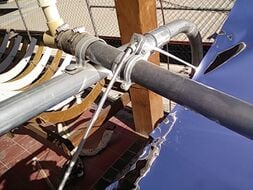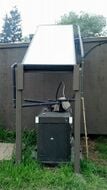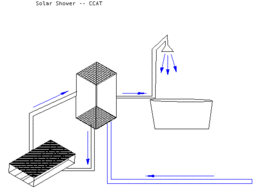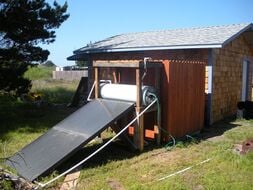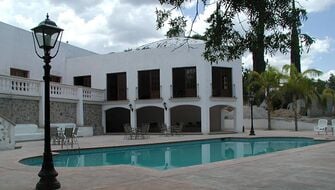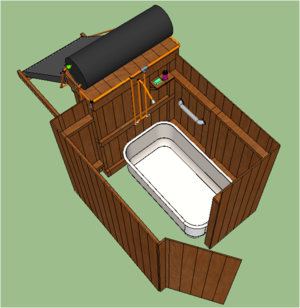
In 2010, Danco and The Humboldt Bay Center for Sustainable Living were in the process of restoring the upstairs of the Samoa Cookhouse and surrounding property into an environmentally friendly, overnight housing facility and campground that aims to educate its guests on sustainable living practices.
Abstract
The goal of this project is to provide the visitors at the Samoa Eco-Hostel with an alternative shower that utilizes renewable energy. The Waterboys designed a solar shower was designed shown in Figure 1. The group members include John Hunter, Omar Abi-Chahine, and Scott Ruud. The main goal of the project was to design and build a shower that uses solar energy to heat the shower water.
Problem and Criteria
Visitors to the Hostel in Samoa do not have a renewable alternative for showering. The objective was to provide campers at the Samoa Hostel with an outdoor shower that utilizes solar energy to heat the water.
The following criteria and constraints were considered for the final solar shower design:
- Privacy - Guests will be showering naked and for their privacy must not be visible to others
- Aesthetics - Product must conform to overall themes of the hostel, those include: rustic, steam punk, and redwood structures
- Education - Guests will be coming from all over the world with various backgrounds
- Warm Shower - Water must be heated exclusively by solar energy
- Safety - Prevent user from falling or injury
- Cost - Least costly options should be pursued with a budget of 425 dollars for the entire project
- Durability - Must last for many years with minimal maintenance to weather conditions and saline air
Final Project
The solution includes a thermosyphon heating system with a redwood enclosure and claw foot bathtub, fitting the hostel's rustic theme, as shown in Figure 1. Attached to the redwood enclosure is a handrail for the guests' safety, and a small shelf. The platform is constructed of redwood, upon which the water tank will be placed. The solar collector is mounted on the structure at a 40 degree angle, allowing for maximum solar exposure. The plumbing consists of three ball valves and two drain valves, labeled in Figures 1 and 2, that can be used to isolate and drain the system. The anti-scald valve is used to set a maximum water temperature in order to prevent user injury. The drip valve prevents pipe cracking by releasing the system pressure as water in the system cools and expands. Water circulates through the system continuously through the process of natural convection. Cold water enters the system through the blue coldwater inlet seen in Figure 2.[1] Inside the tank cold water flows down the blue pipe seen in Figure 3 and enters the solar collector. Water inside the solar collector is heated by the sun and naturally flows to the top of the solar collector and back into the tank through the red pipe shown in Figure 2.[2] Hot water is piped from the top of the water tank, through the user temperature control, and finally provides a warm shower for the user.
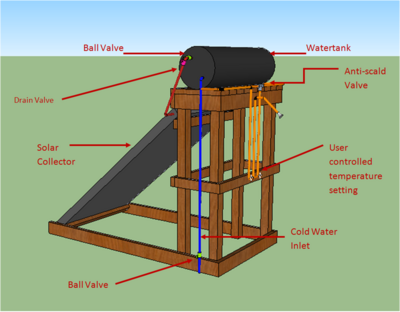
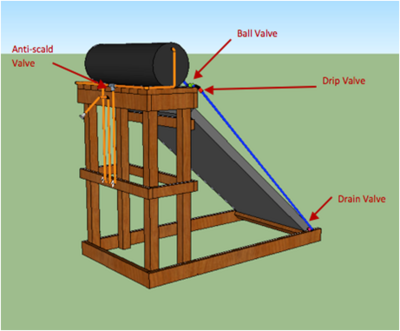
Cost
The cost of the solar shower design is broken down into the design cost, which includes the cost of materials. The implementation cost, which includes total hours worked, and the maintenance of cost of the project.
Design Hours by Phase
The design cost is the total time spent on the planning, construction and testing of the final project.
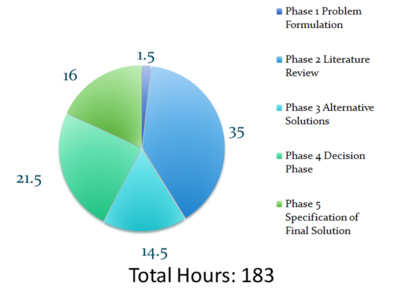
Implementation Cost
The implementation cost of the project is broken down by materials, the quantity needed and the unit cost. The unit cost is per each or when units are noted the price is per that unit. As an educational institution numerous items were able to be donated.
| Materials | Quantity | Unit Cost($) | Actual Cost ($) | Retail Cost ($) |
|---|---|---|---|---|
| 2x4 (12 feet) | 18 | $7.00 | Donated | $126.00 |
| 4x4 (8 feet) | 10 | $12.00 | Donated | $120.00 |
| Redwood Fence Boards | 56 | $3.25 | $182.00 | $182.00 |
| Latch | 1 | $1.99 | $1.99 | $1.99 |
| Hinges | 2 | $2.99 | $5.98 | $5.98 |
| Shower Head | 1 | $35.00 | $35.00 | $35.00 |
| Claw Foot Tub | 1 | $200.00 | $200.00 | $200.00 |
| Copper Pipe (feet) | 30 | $3.00 | Donated | $90.00 |
| Hot Water Heater | 1 | $80.00 | Donated | $80.00 |
| Control Valves | 1 | $40.00 | Unpurchased | $400.00 |
| Pipe Paint (gallon) | 2 | $3.00 | Unpurchased | $6.00 |
| Galvanized Nails | 1 | $200.00 | $200.00 | $200.00 |
| Drain Valve | 2 | $6.00 | Unpurchased | $12.00 |
| Total Cost | $624.97 | $1,458.97 | ||
Maintenance Cost
The solar collector will need to be cleaned regularly to maintain efficiency. Cleaning of the tub and fixtures will also need to be done regularly. To prevent dirt and grime build-up the tub should be cleaned once a month during the winter, and once a week during high use periods. The task of cleaning should take a total of 35 minutes. The system should be checked for leaks once every six months. Due to the high saline environment of the Samoa area, the wood and plumbing will need to be refinished, water-proofed, and repainted once every 5 years.
Discussion and Next Steps
Due to the planning process of the hostel going slower than anticipated, the solar shower will not be completed and tested on-site. The claw foot bathtub and structure components for the solar shower will go into dry storage. When the hostel is at the point of completion that it is ready for installation, the solar shower will be assembled on site.
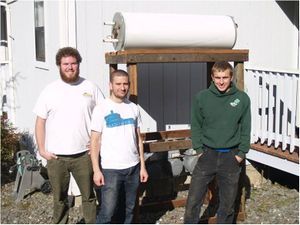
Informational video
Related projects
References
- ↑ Patterson, J. (2010). "Solar Hot Water Basics." Homepower Magazine. <http://web.archive.org/web/20120707212615/http://homepower.com:80/basics/hotwater/> (Sep. 29, 2010).
- ↑ Hemmings, D.; Duncan R.(2010). "RCEA Solar Thermal vs Heat Pump." Appropedia, <https://www.appropedia.org/RCEA_Solar_thermal_vs_Heat_pump> (Sep. 30, 2010).

